University Business Law Assignment 2: Horne v Queensland Case Report
VerifiedAdded on 2019/10/31
|11
|2529
|207
Report
AI Summary
This business law assignment provides a comprehensive analysis of the case Horne v Queensland [1995]. The report details the facts of the case, where a 13-year-old plaintiff was injured in a bicycle accident involving a semi-trailer. It outlines the legal issues, including the breach of duty of care by the school and contributory negligence of the plaintiff. The assignment presents the arguments of both the plaintiff and the defendants, including the State of Queensland, the semi-trailer driver, and the owner of the semi-trailer. It then summarizes the judgments of both the trial court and the appellant court, highlighting the apportionment of responsibility and the critical analysis of the decisions. The report also examines the key legal principles of negligence and duty of care, referencing relevant legal precedents such as Geyer v Downs & Anor and Lynch v Nurdin.
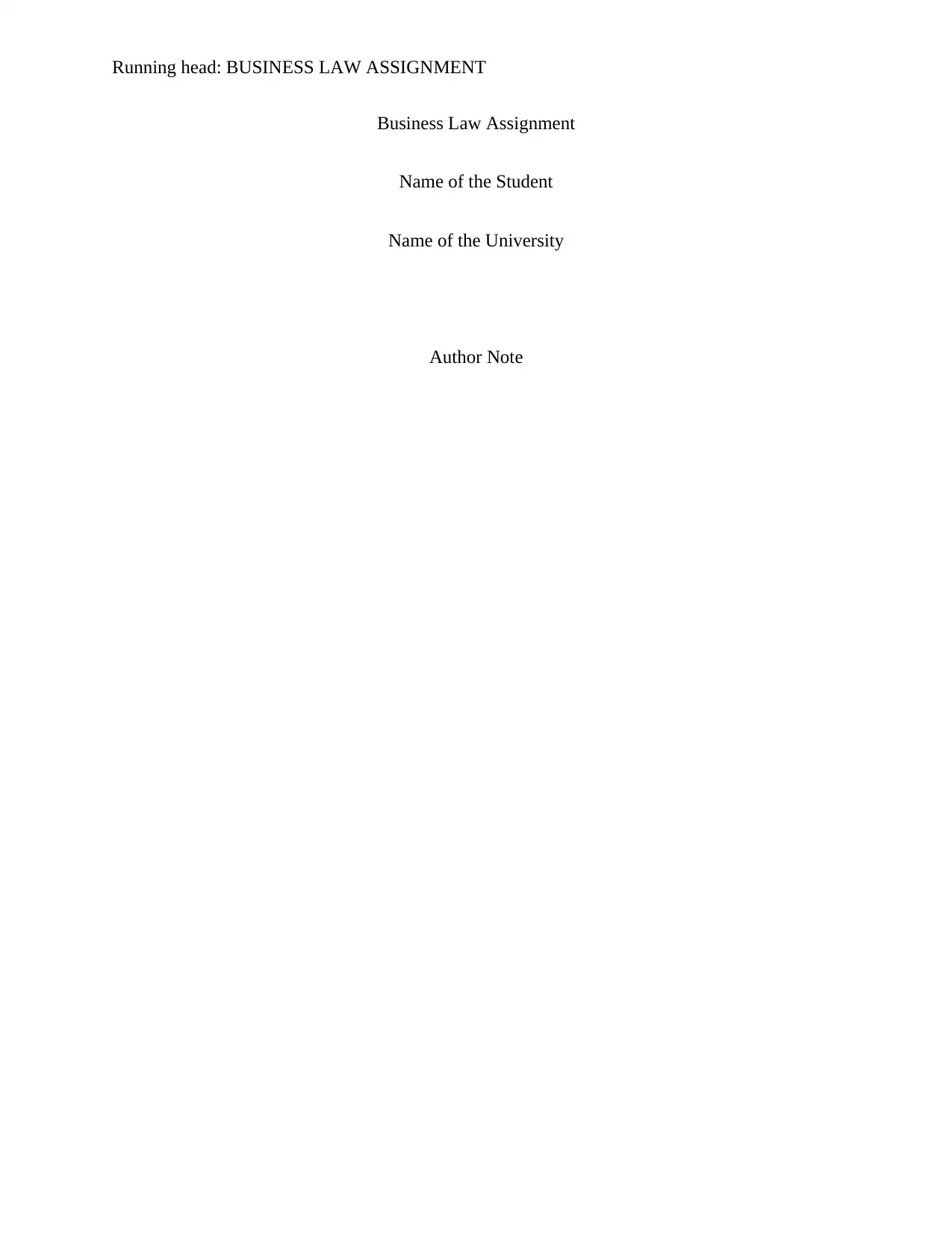
Running head: BUSINESS LAW ASSIGNMENT
Business Law Assignment
Name of the Student
Name of the University
Author Note
Business Law Assignment
Name of the Student
Name of the University
Author Note
Paraphrase This Document
Need a fresh take? Get an instant paraphrase of this document with our AI Paraphraser
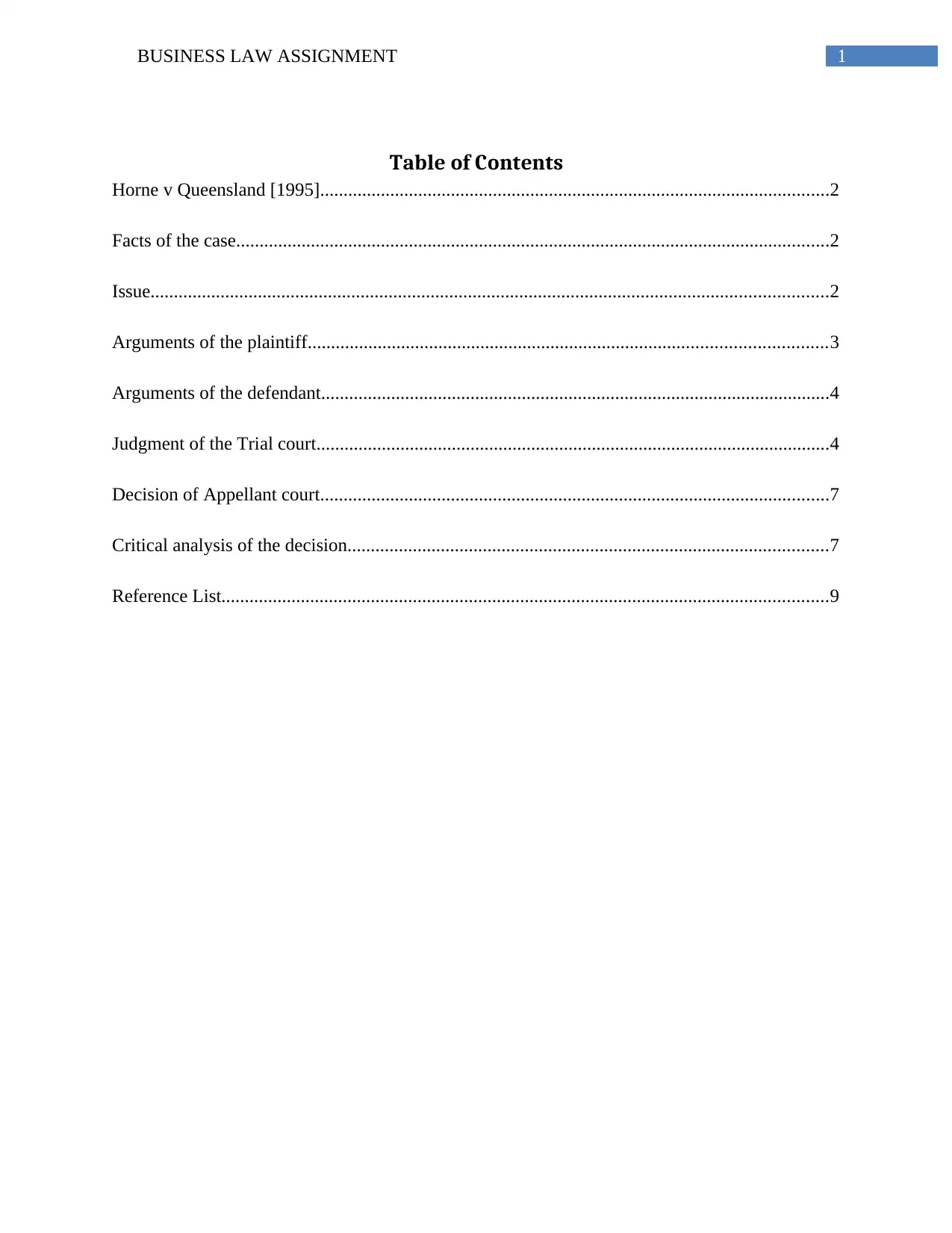
1BUSINESS LAW ASSIGNMENT
Table of Contents
Horne v Queensland [1995].............................................................................................................2
Facts of the case...............................................................................................................................2
Issue.................................................................................................................................................2
Arguments of the plaintiff...............................................................................................................3
Arguments of the defendant.............................................................................................................4
Judgment of the Trial court..............................................................................................................4
Decision of Appellant court.............................................................................................................7
Critical analysis of the decision.......................................................................................................7
Reference List..................................................................................................................................9
Table of Contents
Horne v Queensland [1995].............................................................................................................2
Facts of the case...............................................................................................................................2
Issue.................................................................................................................................................2
Arguments of the plaintiff...............................................................................................................3
Arguments of the defendant.............................................................................................................4
Judgment of the Trial court..............................................................................................................4
Decision of Appellant court.............................................................................................................7
Critical analysis of the decision.......................................................................................................7
Reference List..................................................................................................................................9
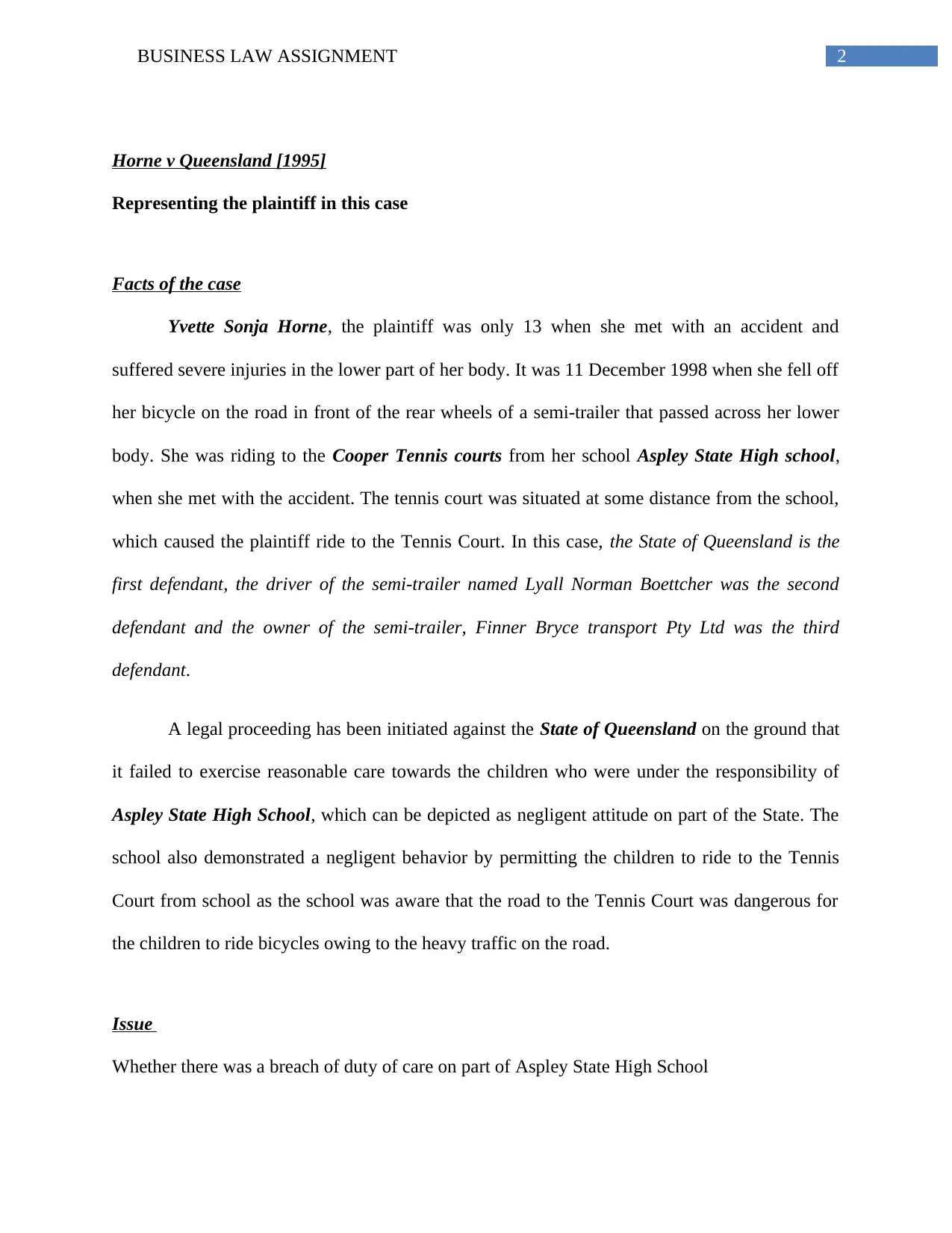
2BUSINESS LAW ASSIGNMENT
Horne v Queensland [1995]
Representing the plaintiff in this case
Facts of the case
Yvette Sonja Horne, the plaintiff was only 13 when she met with an accident and
suffered severe injuries in the lower part of her body. It was 11 December 1998 when she fell off
her bicycle on the road in front of the rear wheels of a semi-trailer that passed across her lower
body. She was riding to the Cooper Tennis courts from her school Aspley State High school,
when she met with the accident. The tennis court was situated at some distance from the school,
which caused the plaintiff ride to the Tennis Court. In this case, the State of Queensland is the
first defendant, the driver of the semi-trailer named Lyall Norman Boettcher was the second
defendant and the owner of the semi-trailer, Finner Bryce transport Pty Ltd was the third
defendant.
A legal proceeding has been initiated against the State of Queensland on the ground that
it failed to exercise reasonable care towards the children who were under the responsibility of
Aspley State High School, which can be depicted as negligent attitude on part of the State. The
school also demonstrated a negligent behavior by permitting the children to ride to the Tennis
Court from school as the school was aware that the road to the Tennis Court was dangerous for
the children to ride bicycles owing to the heavy traffic on the road.
Issue
Whether there was a breach of duty of care on part of Aspley State High School
Horne v Queensland [1995]
Representing the plaintiff in this case
Facts of the case
Yvette Sonja Horne, the plaintiff was only 13 when she met with an accident and
suffered severe injuries in the lower part of her body. It was 11 December 1998 when she fell off
her bicycle on the road in front of the rear wheels of a semi-trailer that passed across her lower
body. She was riding to the Cooper Tennis courts from her school Aspley State High school,
when she met with the accident. The tennis court was situated at some distance from the school,
which caused the plaintiff ride to the Tennis Court. In this case, the State of Queensland is the
first defendant, the driver of the semi-trailer named Lyall Norman Boettcher was the second
defendant and the owner of the semi-trailer, Finner Bryce transport Pty Ltd was the third
defendant.
A legal proceeding has been initiated against the State of Queensland on the ground that
it failed to exercise reasonable care towards the children who were under the responsibility of
Aspley State High School, which can be depicted as negligent attitude on part of the State. The
school also demonstrated a negligent behavior by permitting the children to ride to the Tennis
Court from school as the school was aware that the road to the Tennis Court was dangerous for
the children to ride bicycles owing to the heavy traffic on the road.
Issue
Whether there was a breach of duty of care on part of Aspley State High School
⊘ This is a preview!⊘
Do you want full access?
Subscribe today to unlock all pages.

Trusted by 1+ million students worldwide
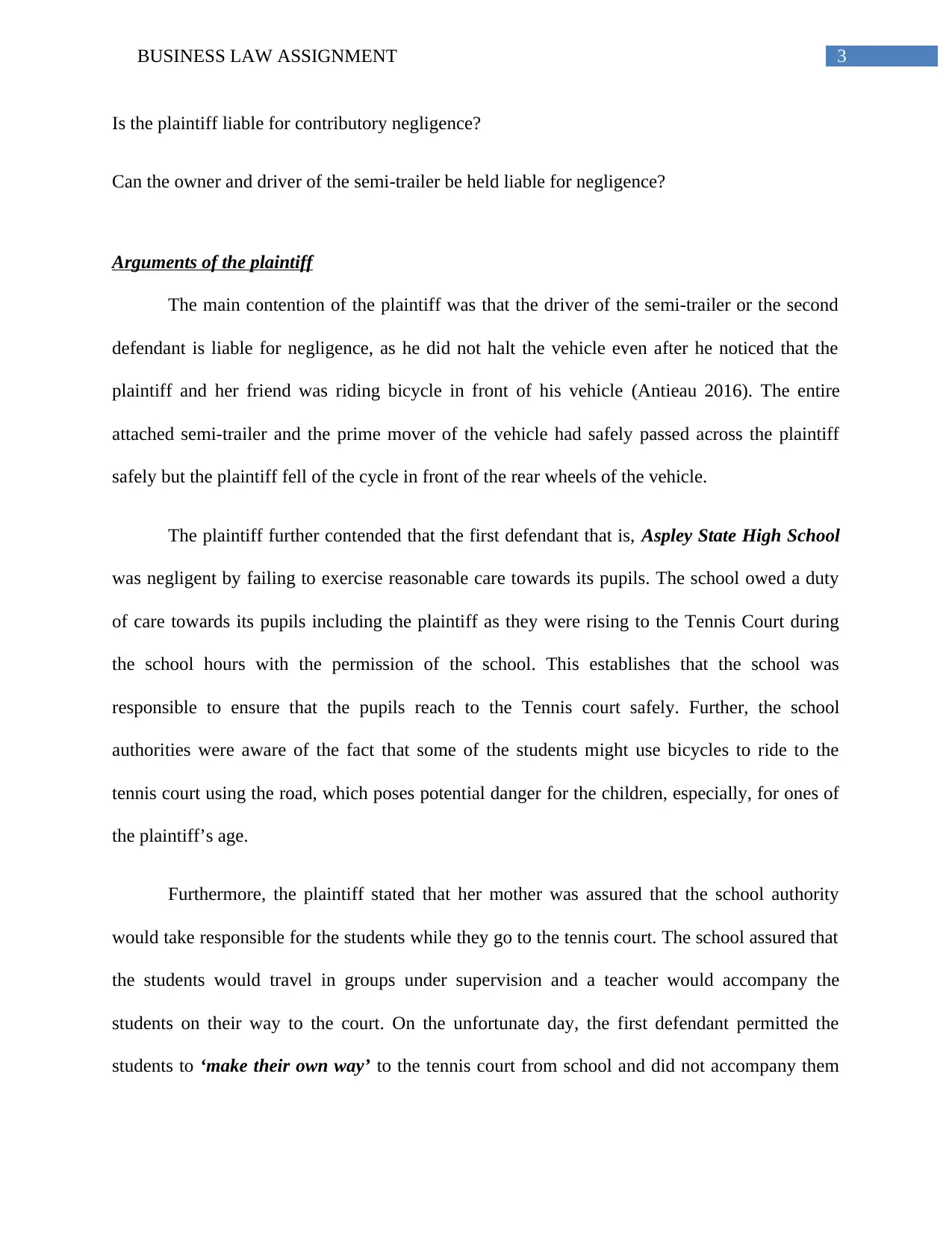
3BUSINESS LAW ASSIGNMENT
Is the plaintiff liable for contributory negligence?
Can the owner and driver of the semi-trailer be held liable for negligence?
Arguments of the plaintiff
The main contention of the plaintiff was that the driver of the semi-trailer or the second
defendant is liable for negligence, as he did not halt the vehicle even after he noticed that the
plaintiff and her friend was riding bicycle in front of his vehicle (Antieau 2016). The entire
attached semi-trailer and the prime mover of the vehicle had safely passed across the plaintiff
safely but the plaintiff fell of the cycle in front of the rear wheels of the vehicle.
The plaintiff further contended that the first defendant that is, Aspley State High School
was negligent by failing to exercise reasonable care towards its pupils. The school owed a duty
of care towards its pupils including the plaintiff as they were rising to the Tennis Court during
the school hours with the permission of the school. This establishes that the school was
responsible to ensure that the pupils reach to the Tennis court safely. Further, the school
authorities were aware of the fact that some of the students might use bicycles to ride to the
tennis court using the road, which poses potential danger for the children, especially, for ones of
the plaintiff’s age.
Furthermore, the plaintiff stated that her mother was assured that the school authority
would take responsible for the students while they go to the tennis court. The school assured that
the students would travel in groups under supervision and a teacher would accompany the
students on their way to the court. On the unfortunate day, the first defendant permitted the
students to ‘make their own way’ to the tennis court from school and did not accompany them
Is the plaintiff liable for contributory negligence?
Can the owner and driver of the semi-trailer be held liable for negligence?
Arguments of the plaintiff
The main contention of the plaintiff was that the driver of the semi-trailer or the second
defendant is liable for negligence, as he did not halt the vehicle even after he noticed that the
plaintiff and her friend was riding bicycle in front of his vehicle (Antieau 2016). The entire
attached semi-trailer and the prime mover of the vehicle had safely passed across the plaintiff
safely but the plaintiff fell of the cycle in front of the rear wheels of the vehicle.
The plaintiff further contended that the first defendant that is, Aspley State High School
was negligent by failing to exercise reasonable care towards its pupils. The school owed a duty
of care towards its pupils including the plaintiff as they were rising to the Tennis Court during
the school hours with the permission of the school. This establishes that the school was
responsible to ensure that the pupils reach to the Tennis court safely. Further, the school
authorities were aware of the fact that some of the students might use bicycles to ride to the
tennis court using the road, which poses potential danger for the children, especially, for ones of
the plaintiff’s age.
Furthermore, the plaintiff stated that her mother was assured that the school authority
would take responsible for the students while they go to the tennis court. The school assured that
the students would travel in groups under supervision and a teacher would accompany the
students on their way to the court. On the unfortunate day, the first defendant permitted the
students to ‘make their own way’ to the tennis court from school and did not accompany them
Paraphrase This Document
Need a fresh take? Get an instant paraphrase of this document with our AI Paraphraser
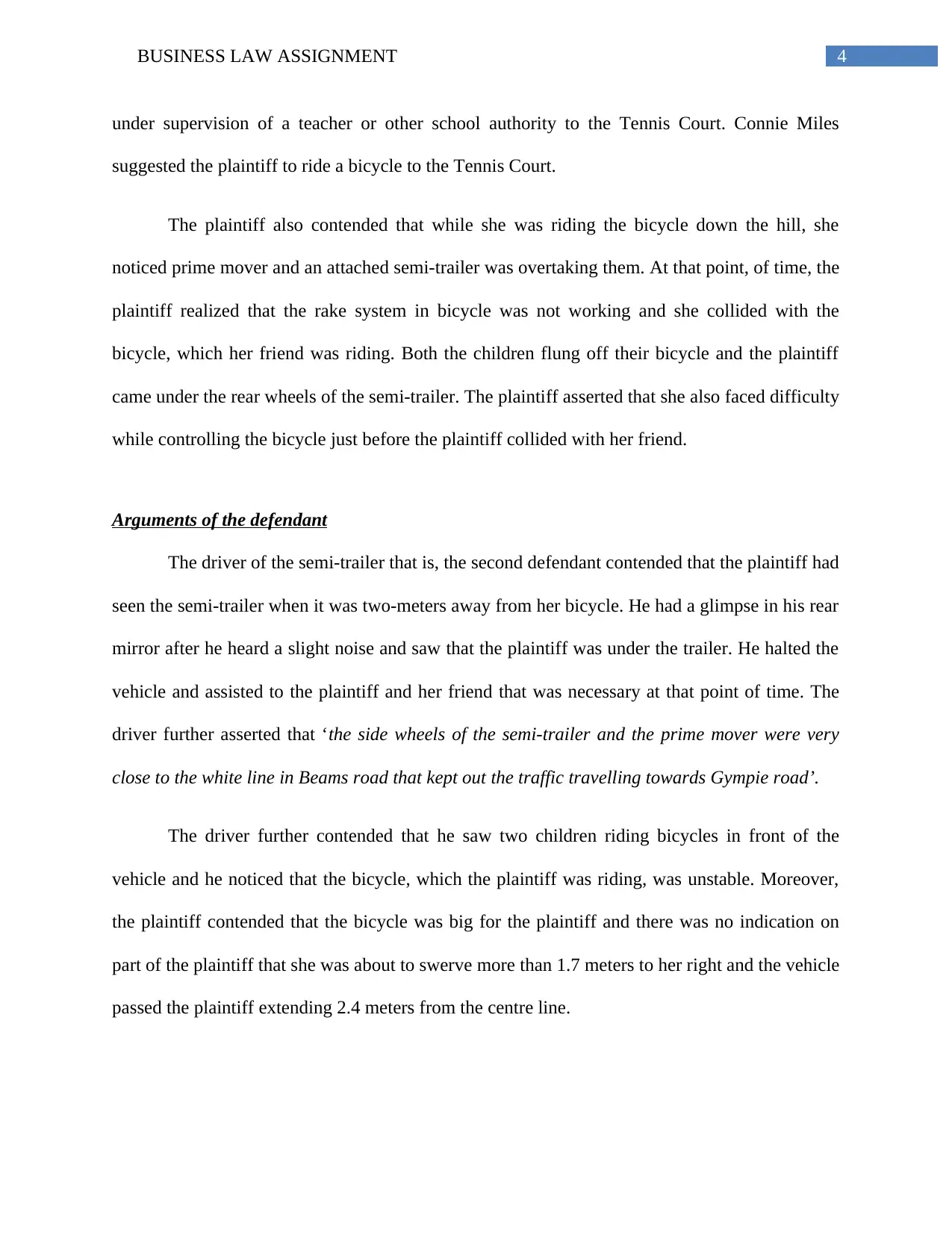
4BUSINESS LAW ASSIGNMENT
under supervision of a teacher or other school authority to the Tennis Court. Connie Miles
suggested the plaintiff to ride a bicycle to the Tennis Court.
The plaintiff also contended that while she was riding the bicycle down the hill, she
noticed prime mover and an attached semi-trailer was overtaking them. At that point, of time, the
plaintiff realized that the rake system in bicycle was not working and she collided with the
bicycle, which her friend was riding. Both the children flung off their bicycle and the plaintiff
came under the rear wheels of the semi-trailer. The plaintiff asserted that she also faced difficulty
while controlling the bicycle just before the plaintiff collided with her friend.
Arguments of the defendant
The driver of the semi-trailer that is, the second defendant contended that the plaintiff had
seen the semi-trailer when it was two-meters away from her bicycle. He had a glimpse in his rear
mirror after he heard a slight noise and saw that the plaintiff was under the trailer. He halted the
vehicle and assisted to the plaintiff and her friend that was necessary at that point of time. The
driver further asserted that ‘the side wheels of the semi-trailer and the prime mover were very
close to the white line in Beams road that kept out the traffic travelling towards Gympie road’.
The driver further contended that he saw two children riding bicycles in front of the
vehicle and he noticed that the bicycle, which the plaintiff was riding, was unstable. Moreover,
the plaintiff contended that the bicycle was big for the plaintiff and there was no indication on
part of the plaintiff that she was about to swerve more than 1.7 meters to her right and the vehicle
passed the plaintiff extending 2.4 meters from the centre line.
under supervision of a teacher or other school authority to the Tennis Court. Connie Miles
suggested the plaintiff to ride a bicycle to the Tennis Court.
The plaintiff also contended that while she was riding the bicycle down the hill, she
noticed prime mover and an attached semi-trailer was overtaking them. At that point, of time, the
plaintiff realized that the rake system in bicycle was not working and she collided with the
bicycle, which her friend was riding. Both the children flung off their bicycle and the plaintiff
came under the rear wheels of the semi-trailer. The plaintiff asserted that she also faced difficulty
while controlling the bicycle just before the plaintiff collided with her friend.
Arguments of the defendant
The driver of the semi-trailer that is, the second defendant contended that the plaintiff had
seen the semi-trailer when it was two-meters away from her bicycle. He had a glimpse in his rear
mirror after he heard a slight noise and saw that the plaintiff was under the trailer. He halted the
vehicle and assisted to the plaintiff and her friend that was necessary at that point of time. The
driver further asserted that ‘the side wheels of the semi-trailer and the prime mover were very
close to the white line in Beams road that kept out the traffic travelling towards Gympie road’.
The driver further contended that he saw two children riding bicycles in front of the
vehicle and he noticed that the bicycle, which the plaintiff was riding, was unstable. Moreover,
the plaintiff contended that the bicycle was big for the plaintiff and there was no indication on
part of the plaintiff that she was about to swerve more than 1.7 meters to her right and the vehicle
passed the plaintiff extending 2.4 meters from the centre line.
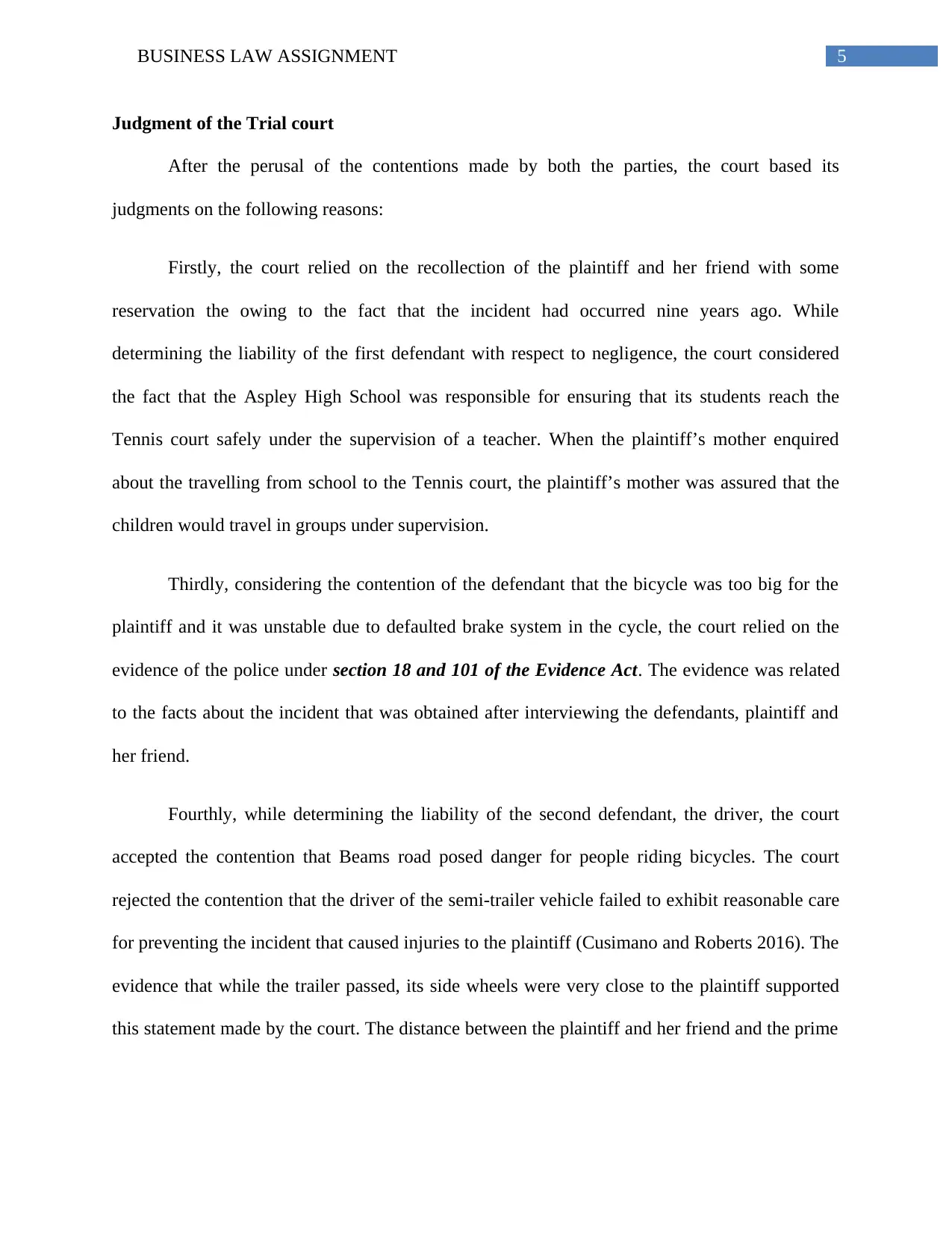
5BUSINESS LAW ASSIGNMENT
Judgment of the Trial court
After the perusal of the contentions made by both the parties, the court based its
judgments on the following reasons:
Firstly, the court relied on the recollection of the plaintiff and her friend with some
reservation the owing to the fact that the incident had occurred nine years ago. While
determining the liability of the first defendant with respect to negligence, the court considered
the fact that the Aspley High School was responsible for ensuring that its students reach the
Tennis court safely under the supervision of a teacher. When the plaintiff’s mother enquired
about the travelling from school to the Tennis court, the plaintiff’s mother was assured that the
children would travel in groups under supervision.
Thirdly, considering the contention of the defendant that the bicycle was too big for the
plaintiff and it was unstable due to defaulted brake system in the cycle, the court relied on the
evidence of the police under section 18 and 101 of the Evidence Act. The evidence was related
to the facts about the incident that was obtained after interviewing the defendants, plaintiff and
her friend.
Fourthly, while determining the liability of the second defendant, the driver, the court
accepted the contention that Beams road posed danger for people riding bicycles. The court
rejected the contention that the driver of the semi-trailer vehicle failed to exhibit reasonable care
for preventing the incident that caused injuries to the plaintiff (Cusimano and Roberts 2016). The
evidence that while the trailer passed, its side wheels were very close to the plaintiff supported
this statement made by the court. The distance between the plaintiff and her friend and the prime
Judgment of the Trial court
After the perusal of the contentions made by both the parties, the court based its
judgments on the following reasons:
Firstly, the court relied on the recollection of the plaintiff and her friend with some
reservation the owing to the fact that the incident had occurred nine years ago. While
determining the liability of the first defendant with respect to negligence, the court considered
the fact that the Aspley High School was responsible for ensuring that its students reach the
Tennis court safely under the supervision of a teacher. When the plaintiff’s mother enquired
about the travelling from school to the Tennis court, the plaintiff’s mother was assured that the
children would travel in groups under supervision.
Thirdly, considering the contention of the defendant that the bicycle was too big for the
plaintiff and it was unstable due to defaulted brake system in the cycle, the court relied on the
evidence of the police under section 18 and 101 of the Evidence Act. The evidence was related
to the facts about the incident that was obtained after interviewing the defendants, plaintiff and
her friend.
Fourthly, while determining the liability of the second defendant, the driver, the court
accepted the contention that Beams road posed danger for people riding bicycles. The court
rejected the contention that the driver of the semi-trailer vehicle failed to exhibit reasonable care
for preventing the incident that caused injuries to the plaintiff (Cusimano and Roberts 2016). The
evidence that while the trailer passed, its side wheels were very close to the plaintiff supported
this statement made by the court. The distance between the plaintiff and her friend and the prime
⊘ This is a preview!⊘
Do you want full access?
Subscribe today to unlock all pages.

Trusted by 1+ million students worldwide
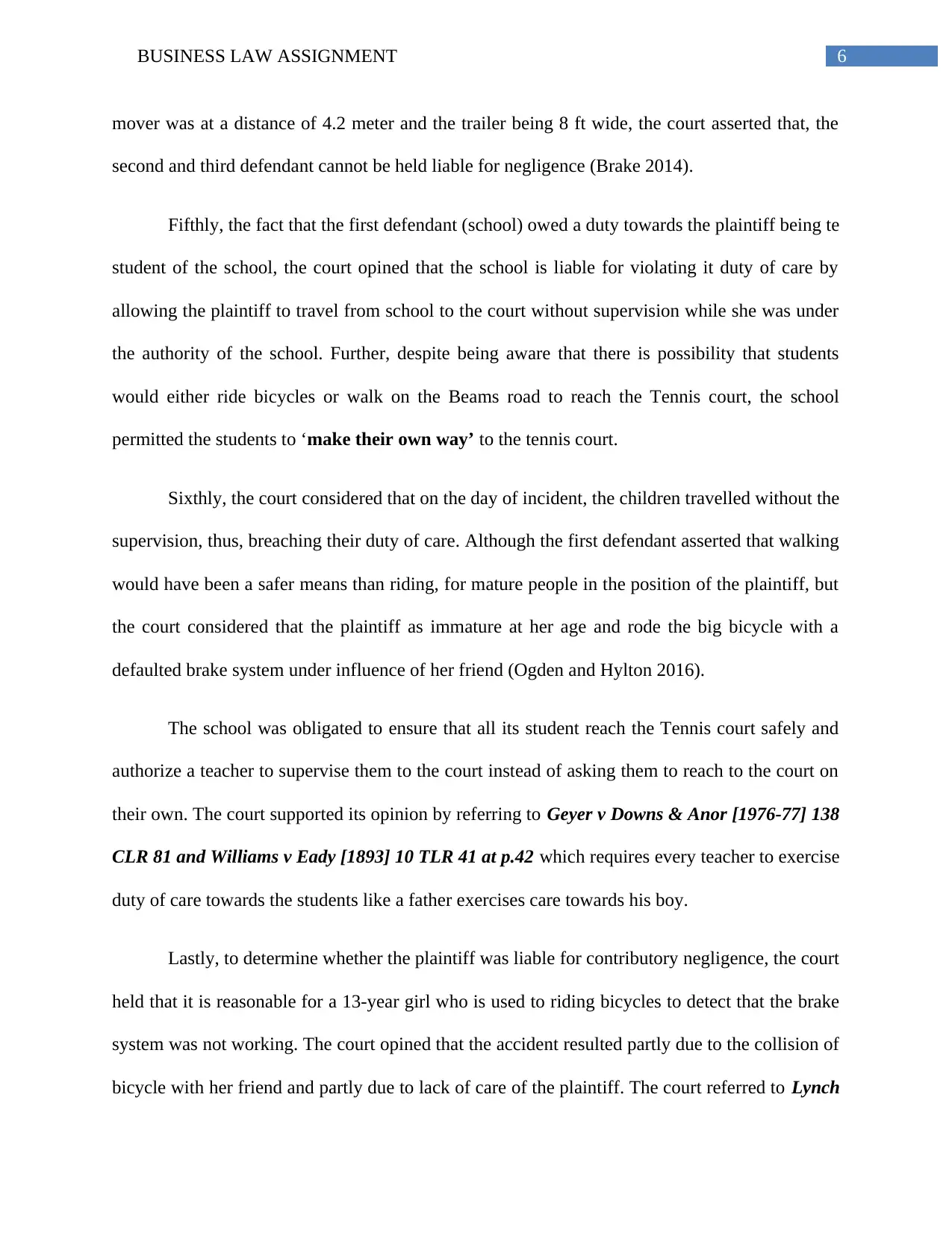
6BUSINESS LAW ASSIGNMENT
mover was at a distance of 4.2 meter and the trailer being 8 ft wide, the court asserted that, the
second and third defendant cannot be held liable for negligence (Brake 2014).
Fifthly, the fact that the first defendant (school) owed a duty towards the plaintiff being te
student of the school, the court opined that the school is liable for violating it duty of care by
allowing the plaintiff to travel from school to the court without supervision while she was under
the authority of the school. Further, despite being aware that there is possibility that students
would either ride bicycles or walk on the Beams road to reach the Tennis court, the school
permitted the students to ‘make their own way’ to the tennis court.
Sixthly, the court considered that on the day of incident, the children travelled without the
supervision, thus, breaching their duty of care. Although the first defendant asserted that walking
would have been a safer means than riding, for mature people in the position of the plaintiff, but
the court considered that the plaintiff as immature at her age and rode the big bicycle with a
defaulted brake system under influence of her friend (Ogden and Hylton 2016).
The school was obligated to ensure that all its student reach the Tennis court safely and
authorize a teacher to supervise them to the court instead of asking them to reach to the court on
their own. The court supported its opinion by referring to Geyer v Downs & Anor [1976-77] 138
CLR 81 and Williams v Eady [1893] 10 TLR 41 at p.42 which requires every teacher to exercise
duty of care towards the students like a father exercises care towards his boy.
Lastly, to determine whether the plaintiff was liable for contributory negligence, the court
held that it is reasonable for a 13-year girl who is used to riding bicycles to detect that the brake
system was not working. The court opined that the accident resulted partly due to the collision of
bicycle with her friend and partly due to lack of care of the plaintiff. The court referred to Lynch
mover was at a distance of 4.2 meter and the trailer being 8 ft wide, the court asserted that, the
second and third defendant cannot be held liable for negligence (Brake 2014).
Fifthly, the fact that the first defendant (school) owed a duty towards the plaintiff being te
student of the school, the court opined that the school is liable for violating it duty of care by
allowing the plaintiff to travel from school to the court without supervision while she was under
the authority of the school. Further, despite being aware that there is possibility that students
would either ride bicycles or walk on the Beams road to reach the Tennis court, the school
permitted the students to ‘make their own way’ to the tennis court.
Sixthly, the court considered that on the day of incident, the children travelled without the
supervision, thus, breaching their duty of care. Although the first defendant asserted that walking
would have been a safer means than riding, for mature people in the position of the plaintiff, but
the court considered that the plaintiff as immature at her age and rode the big bicycle with a
defaulted brake system under influence of her friend (Ogden and Hylton 2016).
The school was obligated to ensure that all its student reach the Tennis court safely and
authorize a teacher to supervise them to the court instead of asking them to reach to the court on
their own. The court supported its opinion by referring to Geyer v Downs & Anor [1976-77] 138
CLR 81 and Williams v Eady [1893] 10 TLR 41 at p.42 which requires every teacher to exercise
duty of care towards the students like a father exercises care towards his boy.
Lastly, to determine whether the plaintiff was liable for contributory negligence, the court
held that it is reasonable for a 13-year girl who is used to riding bicycles to detect that the brake
system was not working. The court opined that the accident resulted partly due to the collision of
bicycle with her friend and partly due to lack of care of the plaintiff. The court referred to Lynch
Paraphrase This Document
Need a fresh take? Get an instant paraphrase of this document with our AI Paraphraser
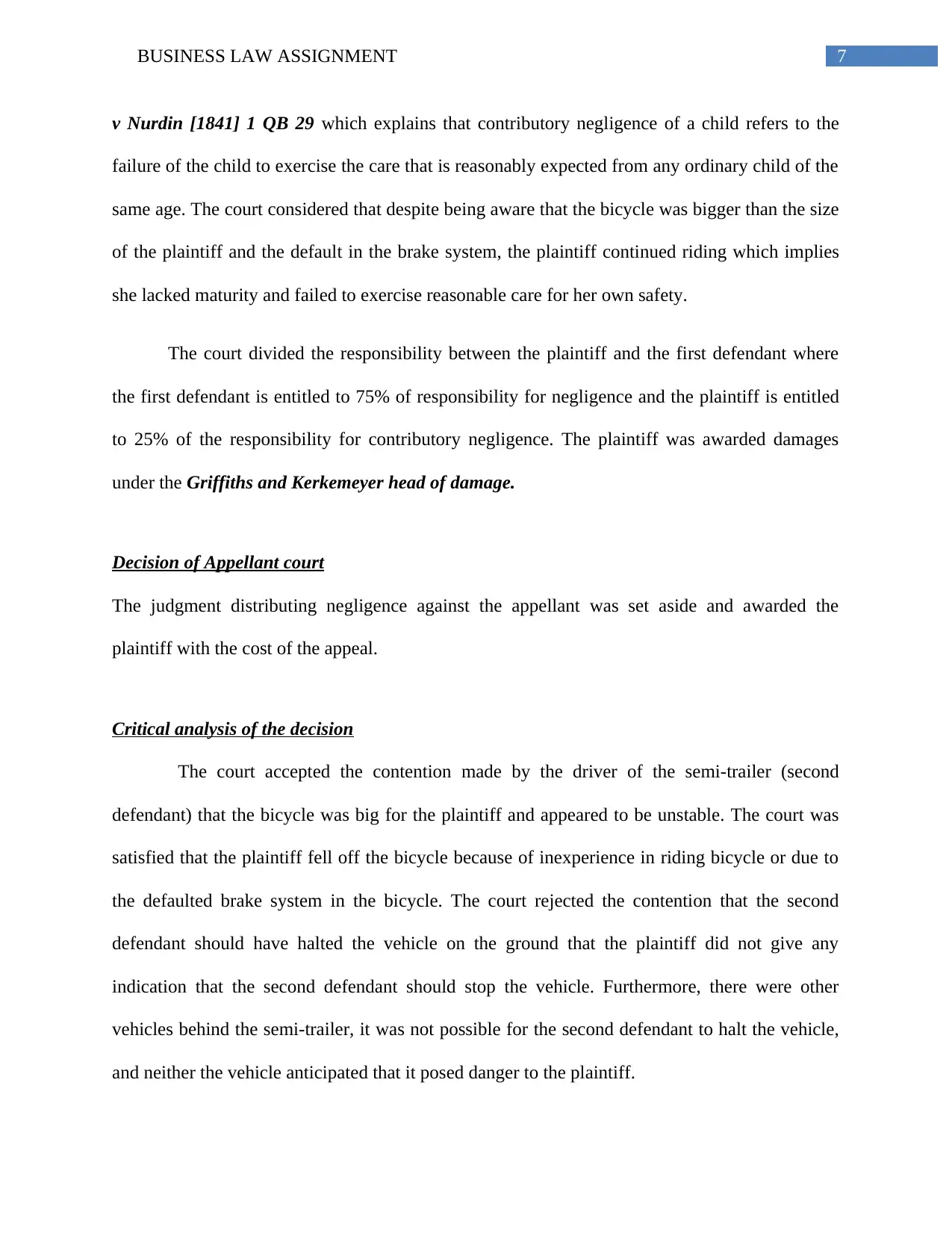
7BUSINESS LAW ASSIGNMENT
v Nurdin [1841] 1 QB 29 which explains that contributory negligence of a child refers to the
failure of the child to exercise the care that is reasonably expected from any ordinary child of the
same age. The court considered that despite being aware that the bicycle was bigger than the size
of the plaintiff and the default in the brake system, the plaintiff continued riding which implies
she lacked maturity and failed to exercise reasonable care for her own safety.
The court divided the responsibility between the plaintiff and the first defendant where
the first defendant is entitled to 75% of responsibility for negligence and the plaintiff is entitled
to 25% of the responsibility for contributory negligence. The plaintiff was awarded damages
under the Griffiths and Kerkemeyer head of damage.
Decision of Appellant court
The judgment distributing negligence against the appellant was set aside and awarded the
plaintiff with the cost of the appeal.
Critical analysis of the decision
The court accepted the contention made by the driver of the semi-trailer (second
defendant) that the bicycle was big for the plaintiff and appeared to be unstable. The court was
satisfied that the plaintiff fell off the bicycle because of inexperience in riding bicycle or due to
the defaulted brake system in the bicycle. The court rejected the contention that the second
defendant should have halted the vehicle on the ground that the plaintiff did not give any
indication that the second defendant should stop the vehicle. Furthermore, there were other
vehicles behind the semi-trailer, it was not possible for the second defendant to halt the vehicle,
and neither the vehicle anticipated that it posed danger to the plaintiff.
v Nurdin [1841] 1 QB 29 which explains that contributory negligence of a child refers to the
failure of the child to exercise the care that is reasonably expected from any ordinary child of the
same age. The court considered that despite being aware that the bicycle was bigger than the size
of the plaintiff and the default in the brake system, the plaintiff continued riding which implies
she lacked maturity and failed to exercise reasonable care for her own safety.
The court divided the responsibility between the plaintiff and the first defendant where
the first defendant is entitled to 75% of responsibility for negligence and the plaintiff is entitled
to 25% of the responsibility for contributory negligence. The plaintiff was awarded damages
under the Griffiths and Kerkemeyer head of damage.
Decision of Appellant court
The judgment distributing negligence against the appellant was set aside and awarded the
plaintiff with the cost of the appeal.
Critical analysis of the decision
The court accepted the contention made by the driver of the semi-trailer (second
defendant) that the bicycle was big for the plaintiff and appeared to be unstable. The court was
satisfied that the plaintiff fell off the bicycle because of inexperience in riding bicycle or due to
the defaulted brake system in the bicycle. The court rejected the contention that the second
defendant should have halted the vehicle on the ground that the plaintiff did not give any
indication that the second defendant should stop the vehicle. Furthermore, there were other
vehicles behind the semi-trailer, it was not possible for the second defendant to halt the vehicle,
and neither the vehicle anticipated that it posed danger to the plaintiff.
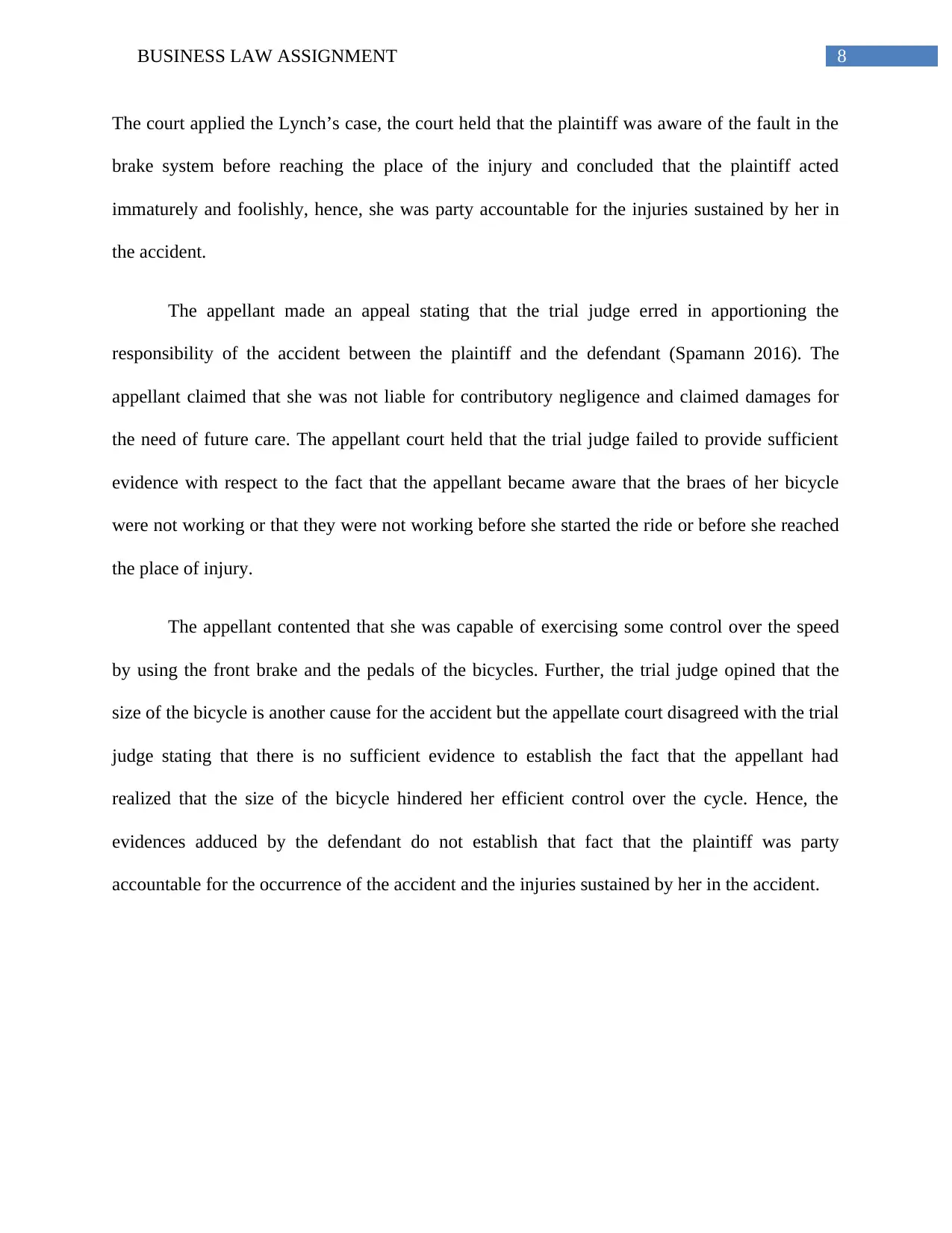
8BUSINESS LAW ASSIGNMENT
The court applied the Lynch’s case, the court held that the plaintiff was aware of the fault in the
brake system before reaching the place of the injury and concluded that the plaintiff acted
immaturely and foolishly, hence, she was party accountable for the injuries sustained by her in
the accident.
The appellant made an appeal stating that the trial judge erred in apportioning the
responsibility of the accident between the plaintiff and the defendant (Spamann 2016). The
appellant claimed that she was not liable for contributory negligence and claimed damages for
the need of future care. The appellant court held that the trial judge failed to provide sufficient
evidence with respect to the fact that the appellant became aware that the braes of her bicycle
were not working or that they were not working before she started the ride or before she reached
the place of injury.
The appellant contented that she was capable of exercising some control over the speed
by using the front brake and the pedals of the bicycles. Further, the trial judge opined that the
size of the bicycle is another cause for the accident but the appellate court disagreed with the trial
judge stating that there is no sufficient evidence to establish the fact that the appellant had
realized that the size of the bicycle hindered her efficient control over the cycle. Hence, the
evidences adduced by the defendant do not establish that fact that the plaintiff was party
accountable for the occurrence of the accident and the injuries sustained by her in the accident.
The court applied the Lynch’s case, the court held that the plaintiff was aware of the fault in the
brake system before reaching the place of the injury and concluded that the plaintiff acted
immaturely and foolishly, hence, she was party accountable for the injuries sustained by her in
the accident.
The appellant made an appeal stating that the trial judge erred in apportioning the
responsibility of the accident between the plaintiff and the defendant (Spamann 2016). The
appellant claimed that she was not liable for contributory negligence and claimed damages for
the need of future care. The appellant court held that the trial judge failed to provide sufficient
evidence with respect to the fact that the appellant became aware that the braes of her bicycle
were not working or that they were not working before she started the ride or before she reached
the place of injury.
The appellant contented that she was capable of exercising some control over the speed
by using the front brake and the pedals of the bicycles. Further, the trial judge opined that the
size of the bicycle is another cause for the accident but the appellate court disagreed with the trial
judge stating that there is no sufficient evidence to establish the fact that the appellant had
realized that the size of the bicycle hindered her efficient control over the cycle. Hence, the
evidences adduced by the defendant do not establish that fact that the plaintiff was party
accountable for the occurrence of the accident and the injuries sustained by her in the accident.
⊘ This is a preview!⊘
Do you want full access?
Subscribe today to unlock all pages.

Trusted by 1+ million students worldwide
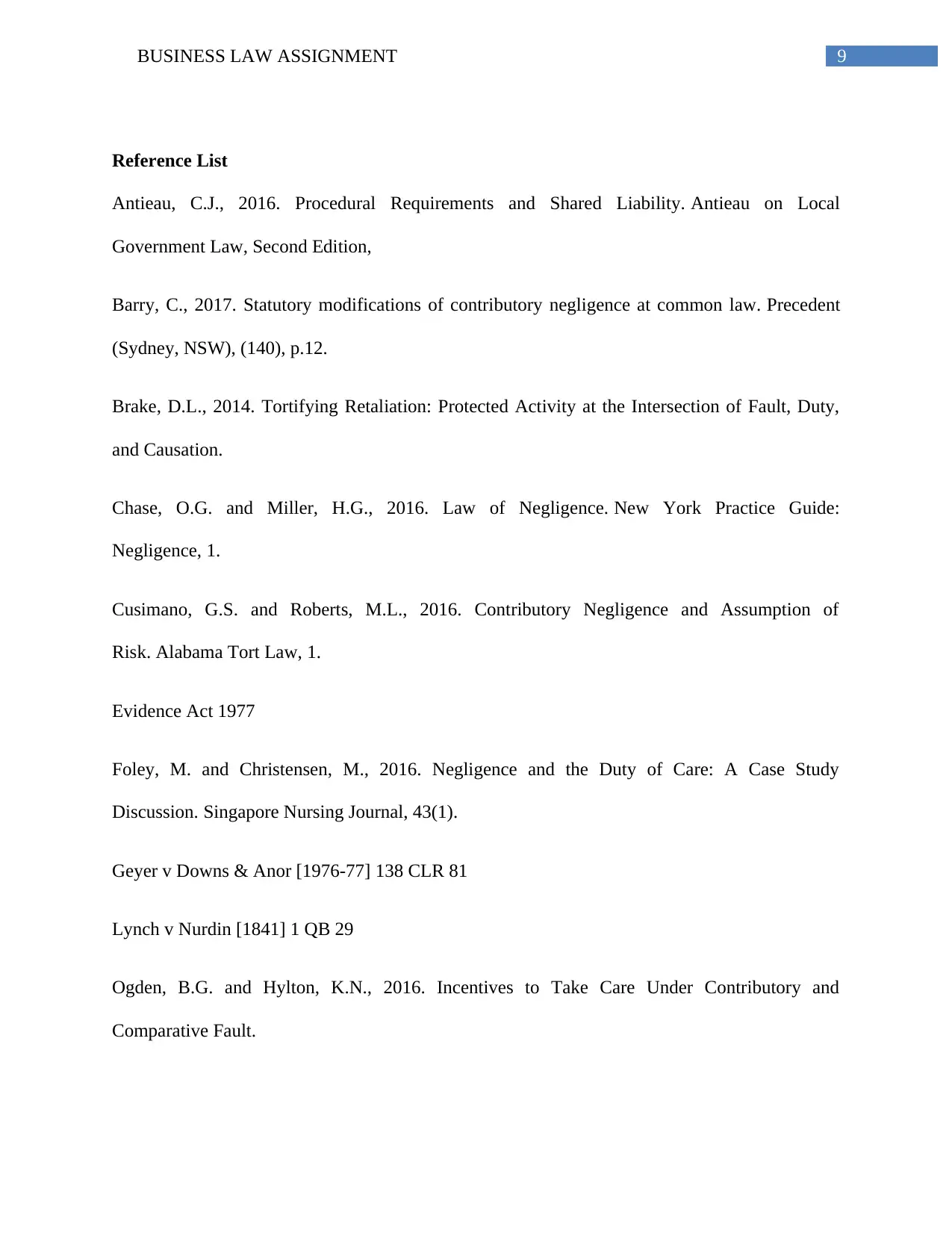
9BUSINESS LAW ASSIGNMENT
Reference List
Antieau, C.J., 2016. Procedural Requirements and Shared Liability. Antieau on Local
Government Law, Second Edition,
Barry, C., 2017. Statutory modifications of contributory negligence at common law. Precedent
(Sydney, NSW), (140), p.12.
Brake, D.L., 2014. Tortifying Retaliation: Protected Activity at the Intersection of Fault, Duty,
and Causation.
Chase, O.G. and Miller, H.G., 2016. Law of Negligence. New York Practice Guide:
Negligence, 1.
Cusimano, G.S. and Roberts, M.L., 2016. Contributory Negligence and Assumption of
Risk. Alabama Tort Law, 1.
Evidence Act 1977
Foley, M. and Christensen, M., 2016. Negligence and the Duty of Care: A Case Study
Discussion. Singapore Nursing Journal, 43(1).
Geyer v Downs & Anor [1976-77] 138 CLR 81
Lynch v Nurdin [1841] 1 QB 29
Ogden, B.G. and Hylton, K.N., 2016. Incentives to Take Care Under Contributory and
Comparative Fault.
Reference List
Antieau, C.J., 2016. Procedural Requirements and Shared Liability. Antieau on Local
Government Law, Second Edition,
Barry, C., 2017. Statutory modifications of contributory negligence at common law. Precedent
(Sydney, NSW), (140), p.12.
Brake, D.L., 2014. Tortifying Retaliation: Protected Activity at the Intersection of Fault, Duty,
and Causation.
Chase, O.G. and Miller, H.G., 2016. Law of Negligence. New York Practice Guide:
Negligence, 1.
Cusimano, G.S. and Roberts, M.L., 2016. Contributory Negligence and Assumption of
Risk. Alabama Tort Law, 1.
Evidence Act 1977
Foley, M. and Christensen, M., 2016. Negligence and the Duty of Care: A Case Study
Discussion. Singapore Nursing Journal, 43(1).
Geyer v Downs & Anor [1976-77] 138 CLR 81
Lynch v Nurdin [1841] 1 QB 29
Ogden, B.G. and Hylton, K.N., 2016. Incentives to Take Care Under Contributory and
Comparative Fault.
Paraphrase This Document
Need a fresh take? Get an instant paraphrase of this document with our AI Paraphraser
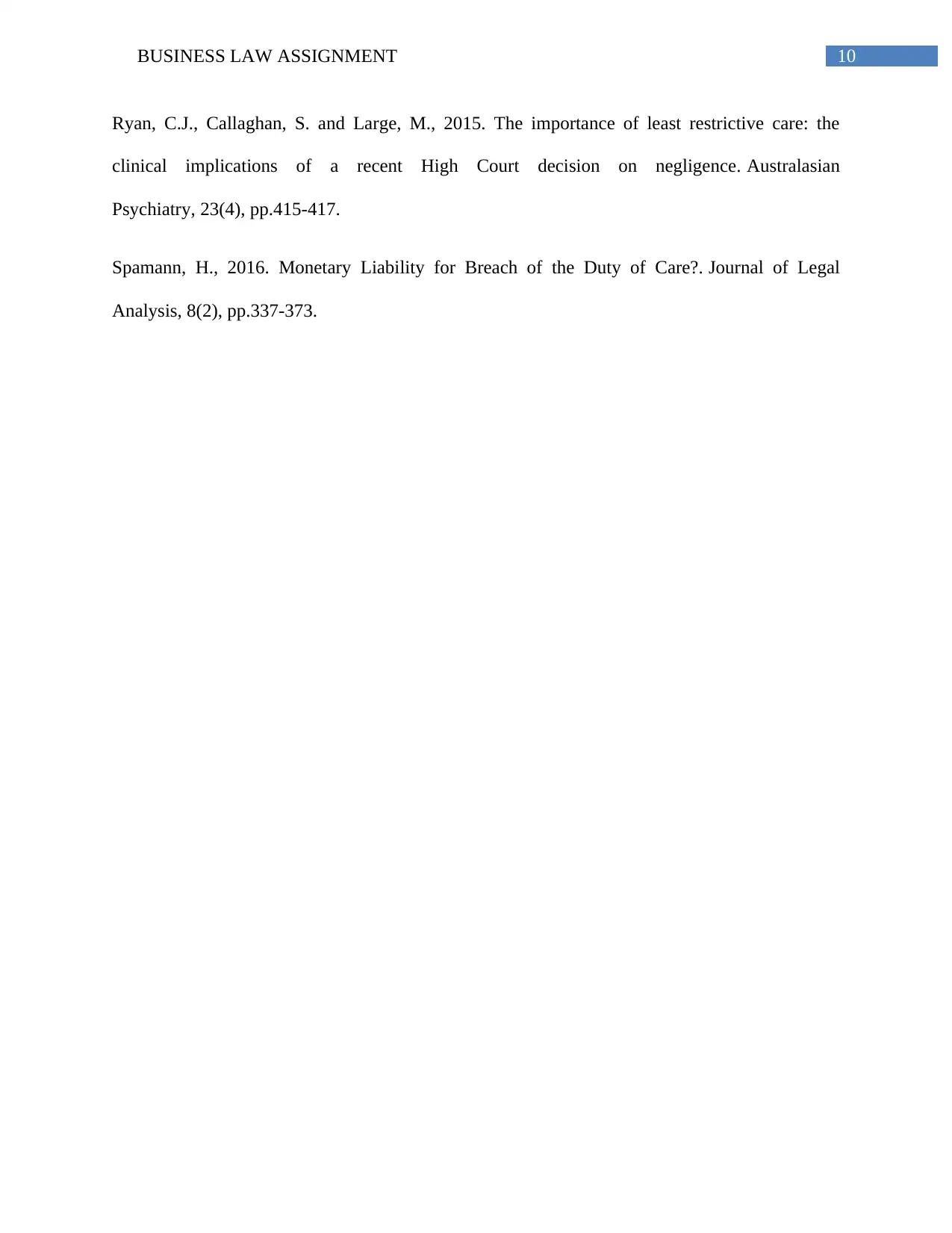
10BUSINESS LAW ASSIGNMENT
Ryan, C.J., Callaghan, S. and Large, M., 2015. The importance of least restrictive care: the
clinical implications of a recent High Court decision on negligence. Australasian
Psychiatry, 23(4), pp.415-417.
Spamann, H., 2016. Monetary Liability for Breach of the Duty of Care?. Journal of Legal
Analysis, 8(2), pp.337-373.
Ryan, C.J., Callaghan, S. and Large, M., 2015. The importance of least restrictive care: the
clinical implications of a recent High Court decision on negligence. Australasian
Psychiatry, 23(4), pp.415-417.
Spamann, H., 2016. Monetary Liability for Breach of the Duty of Care?. Journal of Legal
Analysis, 8(2), pp.337-373.
1 out of 11
Your All-in-One AI-Powered Toolkit for Academic Success.
+13062052269
info@desklib.com
Available 24*7 on WhatsApp / Email
![[object Object]](/_next/static/media/star-bottom.7253800d.svg)
Unlock your academic potential
Copyright © 2020–2025 A2Z Services. All Rights Reserved. Developed and managed by ZUCOL.

